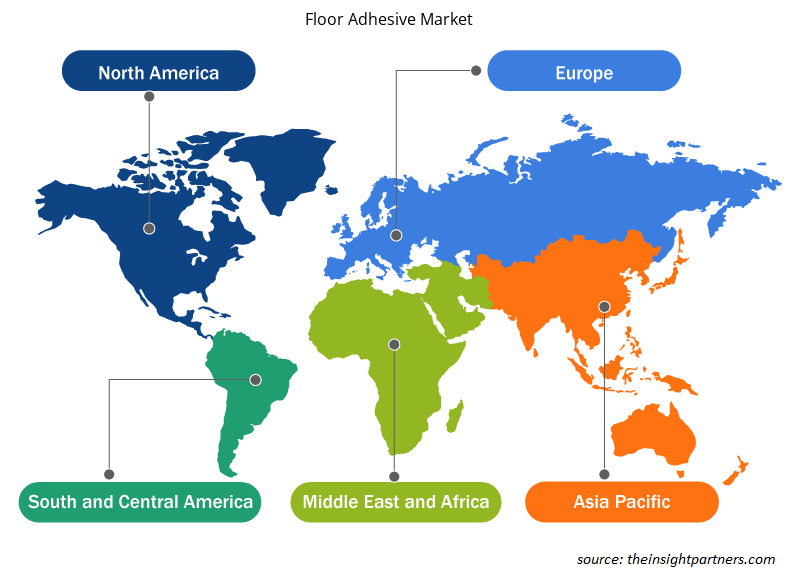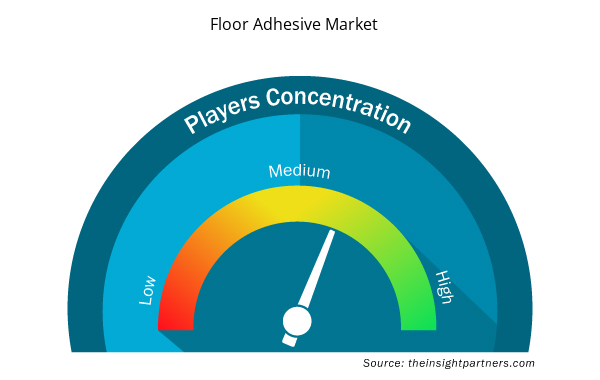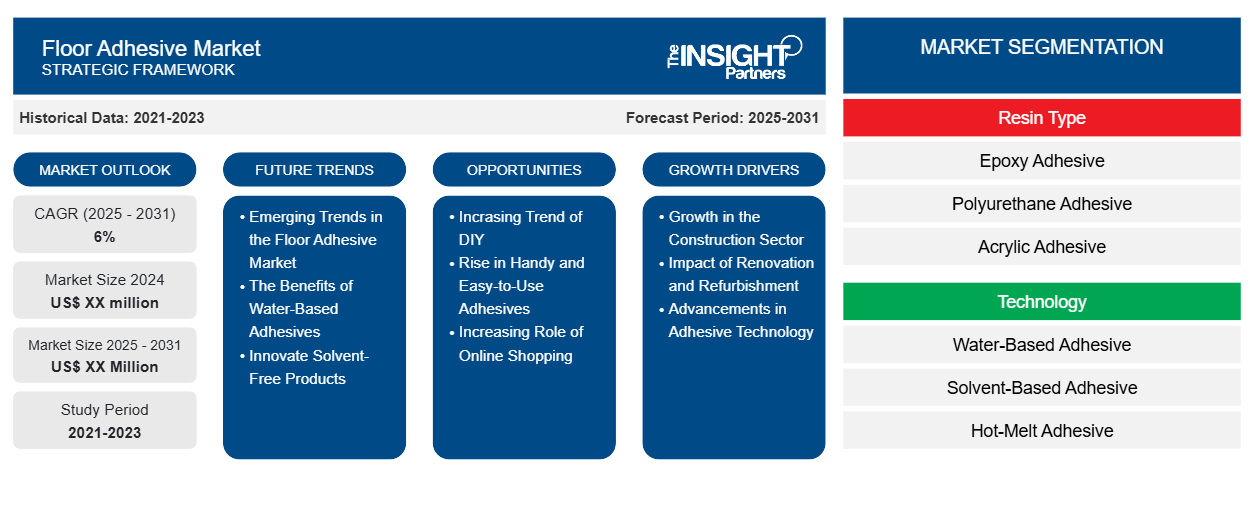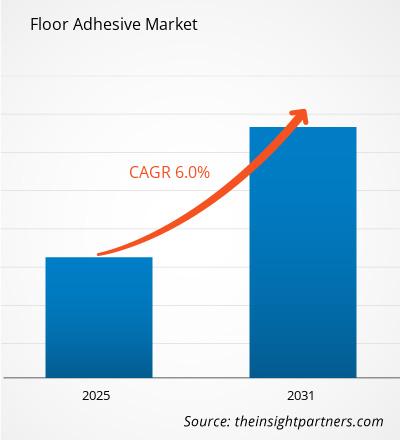من المتوقع أن يسجل سوق المواد اللاصقة للأرضيات معدل نمو سنوي مركب بنسبة 6٪ من عام 2024 إلى عام 2031، مع توسع حجم السوق من XX مليون دولار أمريكي في عام 2024 إلى XX مليون دولار أمريكي بحلول عام 2031.
يقدم التقرير تحليلاً يعتمد على نوع الراتينج (مادة لاصقة إيبوكسي، مادة لاصقة بولي يوريثين، مادة لاصقة أكريليك، مادة لاصقة فينيل، وغيرها). التقرير مجزأ حسب التكنولوجيا (مادة لاصقة قائمة على الماء، مادة لاصقة قائمة على المذيبات، والمادة اللاصقة المنصهرة بالحرارة). التقرير مجزأ حسب التطبيق (البلاط والحجر والخشب والسجاد والصفائح وغيرها). التقرير مجزأ حسب الاستخدام النهائي (مادة لاصقة للأرضيات السكنية، مادة لاصقة للأرضيات التجارية، والمادة اللاصقة للأرضيات الصناعية). يتم تقسيم التحليل العالمي بشكل أكبر على المستوى الإقليمي والدول الرئيسية. يغطي النطاق حجم السوق والتوقعات على المستويات العالمية والإقليمية والقطرية لجميع قطاعات السوق الرئيسية. يقدم التقرير القيمة بالدولار الأمريكي للتحليل والقطاعات المذكورة أعلاه. يقدم التقرير إحصائيات رئيسية عن حالة السوق للاعبين الرئيسيين في السوق ويعرض اتجاهات السوق والفرص.
غرض التقرير
يهدف تقرير سوق المواد اللاصقة للأرضيات الصادر عن The Insight Partners إلى وصف المشهد الحالي والنمو المستقبلي وأهم العوامل الدافعة والتحديات والفرص. وسيوفر هذا رؤى لمختلف أصحاب المصلحة في الأعمال التجارية، مثل:
- مزودي/مصنعي التكنولوجيا: لفهم ديناميكيات السوق المتطورة ومعرفة فرص النمو المحتملة، وتمكينهم من اتخاذ قرارات استراتيجية مستنيرة.
- المستثمرون: إجراء تحليل شامل للاتجاهات فيما يتعلق بمعدل نمو السوق، وتوقعات السوق المالية، والفرص المتاحة عبر سلسلة القيمة.
- الهيئات التنظيمية: لتنظيم السياسات ومراقبة الأنشطة في السوق بهدف تقليل الانتهاكات والحفاظ على ثقة المستثمرين ودعم سلامة السوق واستقرارها.
تجزئة سوق المواد اللاصقة للأرضيات
نوع الراتينج
- لاصق إيبوكسي
- لاصق البولي يوريثين
- لاصق اكريليك
- لاصق الفينيل
تكنولوجيا
- مادة لاصقة مائية
- مادة لاصقة تعتمد على المذيبات
- مادة لاصقة تذوب بالحرارة
قم بتخصيص هذا التقرير ليناسب متطلباتك
ستحصل على تخصيص لأي تقرير - مجانًا - بما في ذلك أجزاء من هذا التقرير، أو تحليل على مستوى الدولة، وحزمة بيانات Excel، بالإضافة إلى الاستفادة من العروض والخصومات الرائعة للشركات الناشئة والجامعات
- احصل على أهم اتجاهات السوق الرئيسية لهذا التقرير.ستتضمن هذه العينة المجانية تحليلاً للبيانات، بدءًا من اتجاهات السوق وحتى التقديرات والتوقعات.
محركات نمو سوق المواد اللاصقة للأرضيات
- النمو في قطاع البناء: يعد النمو في قطاع البناء العامل الرئيسي المحرك لسوق المواد اللاصقة للأرضيات. ومع تسارع وتيرة التحضر وزيادة العمل في قطاع البنية التحتية، تزداد الحاجة إلى حلول الأرضيات عالية الجودة. تعد المواد اللاصقة للأرضيات مكونًا ضروريًا لربط أنواع مختلفة من مواد الأرضيات مثل البلاط والسجاد والفينيل وغيرها من المواد المستخدمة على نطاق واسع في كل من المساحات السكنية والتجارية.
- تأثير التجديد والترميم: بالإضافة إلى ذلك، فإن تجديد وتجديد البنية التحتية القائمة بالفعل يزيد الطلب على المواد اللاصقة للأرضيات بشكل أكبر. وذلك لأن أصحاب المنازل والشركات يستثمرون بشكل أكبر في ترقية التصميمات الداخلية، وهو ما يستلزم عادةً تركيب أرضيات جديدة. كما أن الطلب المتزايد على المواد اللاصقة المرنة وطويلة الأمد التي تضمن روابط متينة تعمل على تعزيز نمو السوق.
- التطورات في تكنولوجيا المواد اللاصقة: تتطور تكنولوجيا المواد اللاصقة بشكل سريع بشكل عام، مما يؤدي إلى زيادة خصائص الأداء من حيث مقاومة الماء والقدرة على التجفيف السريع. وتجذب مثل هذه الابتكارات محترفي البناء الذين يحتاجون إلى منتجات موثوقة يمكنها تسريع عمليات التثبيت. كما تنشأ قواعد ومعايير بناء جديدة تتطلب مواد لاصقة متوافقة وعالية الأداء.
الاتجاهات المستقبلية لسوق المواد اللاصقة للأرضيات
- الاتجاهات الناشئة في سوق المواد اللاصقة للأرضيات: تعد المواد اللاصقة الخالية من الماء والمذيبات من الاتجاهات الناشئة في سوق المواد اللاصقة للأرضيات. وتدفع المخاوف البيئية المتزايدة، مثل تقليل المركبات العضوية المتطايرة (VOCs) والانبعاثات الضارة الأخرى، الشركات المصنعة والمستهلكين نحو الحصول على المزيد من المواد اللاصقة الصديقة للبيئة في تطبيقات الأرضيات.
- فوائد المواد اللاصقة القائمة على الماء: توفر المواد اللاصقة القائمة على الماء بعض الفوائد الملحوظة. فهي عديمة الرائحة أو عطرة، وسهلة التنظيف، وتنطوي على ضرر بيئي أقل. هذه الفوائد للتطبيقات الداخلية تجعلها مفيدة للغاية حيث تشكل جودة الهواء مشكلة داخل المباني. ومع زيادة اليقظة تجاه قضايا الصحة والسلامة، من المرجح أن يزداد استخدام المواد اللاصقة القائمة على الماء في البناء السكني والتجاري.
- ابتكار منتجات خالية من المذيبات: إن المنافسة على التحول إلى منتجات صديقة للبيئة ـ من خلال التنظيم والمبادرة ـ تجبر الشركات المصنعة على إنتاج منتجات مبتكرة خالية من المذيبات. وتتمتع هذه المواد اللاصقة بنفس الأداء العالي الذي تتمتع به نظيراتها القائمة على المذيبات مع انخفاض التأثير الضار على البيئة. ومع تحرك الصناعة نحو معيار أكثر ملاءمة للبيئة، بدأت الشركات تتطلع إلى الداخل لتطوير تركيبات صديقة للبيئة تلبي الاحتياجات التنظيمية وطلبات المستهلكين.
فرص سوق المواد اللاصقة للأرضيات
- الاتجاه المتزايد نحو الأعمال اليدوية: يؤدي الطلب المتزايد على منتجات تركيب الأرضيات التي يمكن تركيبها بنفسك إلى آفاق نمو هائلة في سوق المواد اللاصقة للأرضيات. وقد دفعت أنشطة التجديد المتزايدة بين أصحاب المنازل العديد من الأشخاص إلى البحث عن حلول أرضيات صديقة للمستهلك ويمكن تركيبها بسهولة. وهذا يشجع على تطوير المواد اللاصقة للأرضيات خصيصًا لتطبيقات الأعمال اليدوية، وبالتالي زيادة إمكانات السوق.
- ارتفاع في المواد اللاصقة سهلة الاستخدام: في الوقت الحالي، ينصب اهتمام هواة الأعمال اليدوية على تعدد المهام باستخدام المواد اللاصقة سهلة الاستخدام والتي تضمن قوة كبيرة عند نقطة الالتصاق. وتجذب المواد اللاصقة للأرضيات المصحوبة بتعليمات واضحة والمعبأة بشكل ملائم العملاء الذين ينتمون إلى هذه الفئة وبالتالي فإن المستهلكين أنفسهم يطلبونها بشدة. ومع استمرار ازدهار ثقافة العمل اليدوي، فإن الطلب على المنتجات المتخصصة سوف يستمر في التقدم.
- الدور المتزايد للتسوق عبر الإنترنت: علاوة على ذلك، فإن طرق التسوق عبر الإنترنت تجعل المواد التي يمكن شراؤها بنفسك للأرضيات متاحة أيضًا. يمكن للمستهلكين بسهولة مقارنة المنتجات والعثور على مواد لاصقة مناسبة للأرضيات لتلبية متطلباتهم. تساهم هذه السهولة المتزايدة في توسيع السوق مع بدء المزيد من الأفراد في أنشطة تحسين المنزل.
رؤى إقليمية حول سوق المواد اللاصقة للأرضيات
لقد قام المحللون في Insight Partners بشرح الاتجاهات والعوامل الإقليمية المؤثرة على سوق المواد اللاصقة للأرضيات طوال فترة التوقعات بشكل شامل. يناقش هذا القسم أيضًا قطاعات سوق المواد اللاصقة للأرضيات والجغرافيا في جميع أنحاء أمريكا الشمالية وأوروبا ومنطقة آسيا والمحيط الهادئ والشرق الأوسط وأفريقيا وأمريكا الجنوبية والوسطى.

- احصل على البيانات الإقليمية المحددة لسوق المواد اللاصقة للأرضيات
نطاق تقرير سوق المواد اللاصقة للأرضيات
| سمة التقرير | تفاصيل |
|---|---|
| حجم السوق في عام 2024 | XX مليون دولار أمريكي |
| حجم السوق بحلول عام 2031 | XX مليون دولار أمريكي |
| معدل النمو السنوي المركب العالمي (2025 - 2031) | 6% |
| البيانات التاريخية | 2021-2023 |
| فترة التنبؤ | 2025-2031 |
| القطاعات المغطاة | حسب نوع الراتينج
|
| المناطق والدول المغطاة | أمريكا الشمالية
|
| قادة السوق وملفات تعريف الشركات الرئيسية |
|
كثافة اللاعبين في سوق المواد اللاصقة للأرضيات: فهم تأثيرها على ديناميكيات الأعمال
يشهد سوق المواد اللاصقة للأرضيات نموًا سريعًا، مدفوعًا بالطلب المتزايد من المستخدم النهائي بسبب عوامل مثل تفضيلات المستهلكين المتطورة والتقدم التكنولوجي والوعي المتزايد بفوائد المنتج. ومع ارتفاع الطلب، تعمل الشركات على توسيع عروضها والابتكار لتلبية احتياجات المستهلكين والاستفادة من الاتجاهات الناشئة، مما يؤدي إلى زيادة نمو السوق.
تشير كثافة اللاعبين في السوق إلى توزيع الشركات أو المؤسسات العاملة في سوق أو صناعة معينة. وهي تشير إلى عدد المنافسين (اللاعبين في السوق) الموجودين في مساحة سوق معينة نسبة إلى حجمها أو قيمتها السوقية الإجمالية.
الشركات الرئيسية العاملة في سوق المواد اللاصقة للأرضيات هي:
- شركة بوسيتك الهندية المحدودة
- شركة دوبون دي نيمورس
- شركة فوربو القابضة
- شركة اتش بي فولر
- شركة هنكل ايه جي وشركاه
إخلاء المسؤولية : الشركات المذكورة أعلاه ليست مرتبة بأي ترتيب معين.

- احصل على نظرة عامة على أهم اللاعبين الرئيسيين في سوق المواد اللاصقة للأرضيات
نقاط البيع الرئيسية
- التغطية الشاملة: يغطي التقرير بشكل شامل تحليل المنتجات والخدمات والأنواع والمستخدمين النهائيين لسوق المواد اللاصقة للأرضيات، مما يوفر صورة شاملة.
- تحليل الخبراء: تم تجميع التقرير على أساس الفهم العميق لخبراء الصناعة والمحللين.
- معلومات محدثة: يضمن التقرير أهمية الأعمال التجارية بسبب تغطيته للمعلومات الحديثة واتجاهات البيانات.
- خيارات التخصيص: يمكن تخصيص هذا التقرير لتلبية متطلبات العملاء المحددة وبما يتناسب مع استراتيجيات العمل بشكل مناسب.
وبالتالي، فإن تقرير البحث حول سوق المواد اللاصقة للأرضيات يمكن أن يساعد في تمهيد الطريق لفك شفرة وفهم سيناريو الصناعة وآفاق النمو. ورغم وجود بعض المخاوف المشروعة، فإن الفوائد الإجمالية لهذا التقرير تميل إلى التفوق على العيوب.
- التحليل التاريخي (سنتان)، السنة الأساسية، التوقعات (7 سنوات) مع معدل النمو السنوي المركب
- تحليل PEST و SWOT
- حجم السوق والقيمة / الحجم - عالميًا وإقليميًا وقطريًا
- الصناعة والمنافسة
- مجموعة بيانات Excel



Report Coverage
Revenue forecast, Company Analysis, Industry landscape, Growth factors, and Trends

Segment Covered
This text is related
to segments covered.

Regional Scope
North America, Europe, Asia Pacific, Middle East & Africa, South & Central America

Country Scope
This text is related
to country scope.
الأسئلة الشائعة
The shift towards water-based and solvent-free adhesives is expected to be the key market trends.
Based on resin type, the polyurethane adhesive segment is expected to witness the fastest growth during the forecast period
Based on geography, Asia Pacific held the largest share of the floor adhesive market due to the region's rapid urbanization and population growth have led to an increased demand for residential and commercial construction.
The growing construction industry is driving the market growth.
Bostik India Pvt. Ltd.; Dupont De Nemours Inc.; Forbo Holding AG; H.B Fuller Company; Henkel AG and Co. Kgaa; Laticrete International Inc.; Mapei S.P.A; Pidilite Industries Limited; Sika AG; and Wacker Chemie AG are some of the key players operating in the floor adhesive market
The Floor Adhesive Market is estimated to witness a CAGR of 6% from 2023 to 2031
1.Bostik India Pvt. Ltd.
2.Dupont De Nemours Inc.
3.Forbo Holding AG
4.H.B Fuller Company
5.Henkel AG and Co. Kgaa
6.Laticrete International Inc.
7.Mapei S.P.A
8.Pidilite Industries Limited
9.Sika AG
10.Wacker Chemie AG
The Insight Partners performs research in 4 major stages: Data Collection & Secondary Research, Primary Research, Data Analysis and Data Triangulation & Final Review.
- Data Collection and Secondary Research:
As a market research and consulting firm operating from a decade, we have published and advised several client across the globe. First step for any study will start with an assessment of currently available data and insights from existing reports. Further, historical and current market information is collected from Investor Presentations, Annual Reports, SEC Filings, etc., and other information related to company’s performance and market positioning are gathered from Paid Databases (Factiva, Hoovers, and Reuters) and various other publications available in public domain.
Several associations trade associates, technical forums, institutes, societies and organization are accessed to gain technical as well as market related insights through their publications such as research papers, blogs and press releases related to the studies are referred to get cues about the market. Further, white papers, journals, magazines, and other news articles published in last 3 years are scrutinized and analyzed to understand the current market trends.
- Primary Research:
The primarily interview analysis comprise of data obtained from industry participants interview and answers to survey questions gathered by in-house primary team.
For primary research, interviews are conducted with industry experts/CEOs/Marketing Managers/VPs/Subject Matter Experts from both demand and supply side to get a 360-degree view of the market. The primary team conducts several interviews based on the complexity of the markets to understand the various market trends and dynamics which makes research more credible and precise.
A typical research interview fulfils the following functions:
- Provides first-hand information on the market size, market trends, growth trends, competitive landscape, and outlook
- Validates and strengthens in-house secondary research findings
- Develops the analysis team’s expertise and market understanding
Primary research involves email interactions and telephone interviews for each market, category, segment, and sub-segment across geographies. The participants who typically take part in such a process include, but are not limited to:
- Industry participants: VPs, business development managers, market intelligence managers and national sales managers
- Outside experts: Valuation experts, research analysts and key opinion leaders specializing in the electronics and semiconductor industry.
Below is the breakup of our primary respondents by company, designation, and region:

Once we receive the confirmation from primary research sources or primary respondents, we finalize the base year market estimation and forecast the data as per the macroeconomic and microeconomic factors assessed during data collection.
- Data Analysis:
Once data is validated through both secondary as well as primary respondents, we finalize the market estimations by hypothesis formulation and factor analysis at regional and country level.
- Macro-Economic Factor Analysis:
We analyse macroeconomic indicators such the gross domestic product (GDP), increase in the demand for goods and services across industries, technological advancement, regional economic growth, governmental policies, the influence of COVID-19, PEST analysis, and other aspects. This analysis aids in setting benchmarks for various nations/regions and approximating market splits. Additionally, the general trend of the aforementioned components aid in determining the market's development possibilities.
- Country Level Data:
Various factors that are especially aligned to the country are taken into account to determine the market size for a certain area and country, including the presence of vendors, such as headquarters and offices, the country's GDP, demand patterns, and industry growth. To comprehend the market dynamics for the nation, a number of growth variables, inhibitors, application areas, and current market trends are researched. The aforementioned elements aid in determining the country's overall market's growth potential.
- Company Profile:
The “Table of Contents” is formulated by listing and analyzing more than 25 - 30 companies operating in the market ecosystem across geographies. However, we profile only 10 companies as a standard practice in our syndicate reports. These 10 companies comprise leading, emerging, and regional players. Nonetheless, our analysis is not restricted to the 10 listed companies, we also analyze other companies present in the market to develop a holistic view and understand the prevailing trends. The “Company Profiles” section in the report covers key facts, business description, products & services, financial information, SWOT analysis, and key developments. The financial information presented is extracted from the annual reports and official documents of the publicly listed companies. Upon collecting the information for the sections of respective companies, we verify them via various primary sources and then compile the data in respective company profiles. The company level information helps us in deriving the base number as well as in forecasting the market size.
- Developing Base Number:
Aggregation of sales statistics (2020-2022) and macro-economic factor, and other secondary and primary research insights are utilized to arrive at base number and related market shares for 2022. The data gaps are identified in this step and relevant market data is analyzed, collected from paid primary interviews or databases. On finalizing the base year market size, forecasts are developed on the basis of macro-economic, industry and market growth factors and company level analysis.
- Data Triangulation and Final Review:
The market findings and base year market size calculations are validated from supply as well as demand side. Demand side validations are based on macro-economic factor analysis and benchmarks for respective regions and countries. In case of supply side validations, revenues of major companies are estimated (in case not available) based on industry benchmark, approximate number of employees, product portfolio, and primary interviews revenues are gathered. Further revenue from target product/service segment is assessed to avoid overshooting of market statistics. In case of heavy deviations between supply and demand side values, all thes steps are repeated to achieve synchronization.
We follow an iterative model, wherein we share our research findings with Subject Matter Experts (SME’s) and Key Opinion Leaders (KOLs) until consensus view of the market is not formulated – this model negates any drastic deviation in the opinions of experts. Only validated and universally acceptable research findings are quoted in our reports.
We have important check points that we use to validate our research findings – which we call – data triangulation, where we validate the information, we generate from secondary sources with primary interviews and then we re-validate with our internal data bases and Subject matter experts. This comprehensive model enables us to deliver high quality, reliable data in shortest possible time.


 احصل على عينة مجانية لهذا التقرير
احصل على عينة مجانية لهذا التقرير